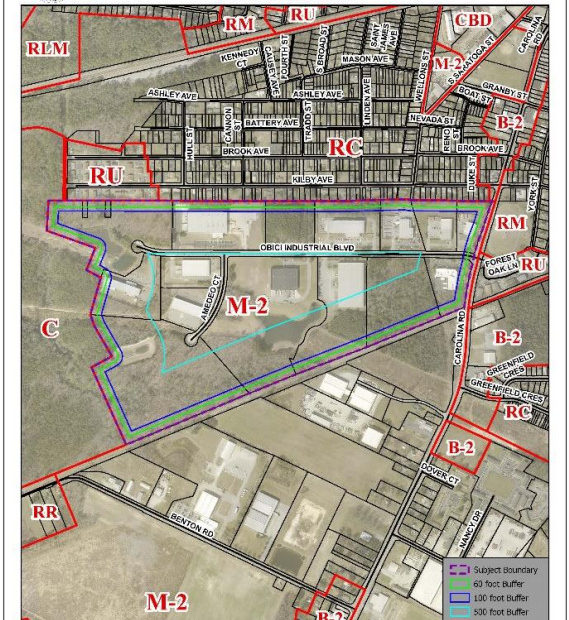In September, we wrote about the City of Suffolk’s plan to add warehouse regulations to the UDO (Unified Development Ordinance). We applauded the city for addressing a glaring omission in the UDO – the lack of guidelines for the building of warehouses. We may have been too hasty in our praise.
When the Planning Department first proposed the text amendment, the setbacks for warehouses were going to be set to 30 feet, which is already the minimum standard for M-1 and M-2 zoning. Citizens Voice, a group of concerned citizens, met with the city personnel before the September 20th City Council meeting, providing well-researched documentation regarding setbacks. They also provided feedback during the public hearing, presenting a petition signed by Suffolk residents along with responses to a survey they had sent out. The citizens of Suffolk want larger setbacks. Even Mayor Duman agreed that 30 feet is not enough.
A 30-foot setback is about the same length as two averaged-sized cars parked bumper to bumper. That is not much of a buffer. Do you know what else requires a 30-foot setback in the City of Suffolk? According to the UDO TABLE 407-1: DIMENSIONAL STANDARDS, houses built in the RLM (Residential Low Medium density) are required to have minimum front and rear setbacks of 30 feet each.
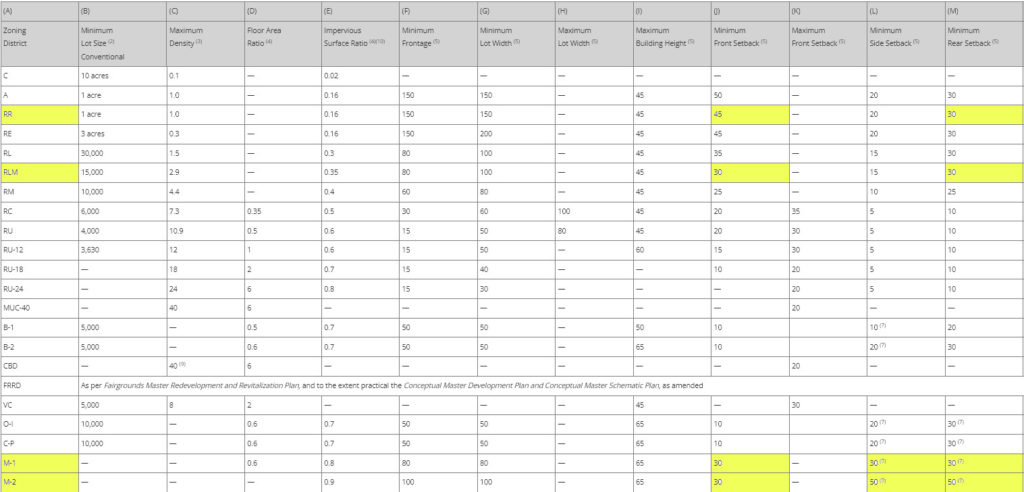
The table above is from the UDO TABLE 407-1: DIMENSIONAL STANDARDS as lists the setbacks required in the City of Suffolk based on the zoning district. The highlights sections relate to the RR, RLM, M-1, and M-2 zoning districts’ minimum setback requirements.
That’s right: if you purchase a half-acre lot and want to build a 2,100 square foot house (average size in Virginia) on a RLM lot, you will have to make sure your home is 30 feet from the road and 30 feet from the rear property line, the same as a warehouse in a M-1 or M-2 zoning district. If you build that same house on a one acre Rural Residential (RR) lot, you better make sure the setback is 45 feet from the road. In other words, 15 feet further back than a warehouse is required to be.
To be clear, the City’s stated purpose for this amendment is: “To mitigate potential adverse impacts of warehouses and warehousing uses on adjacent public property, residential uses, institutional uses, or recreational uses, and the public roadway network.” With this in mind, do they really think a 45-foot tall warehouse with no minimum lot size and no limitations on square footage, should actually be placed CLOSER to the road frontage than a 2,100 square foot house on a 1 acre lot?
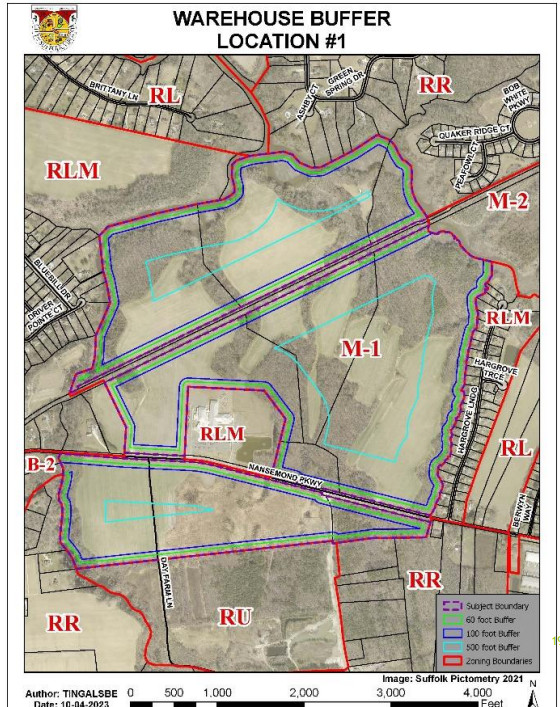
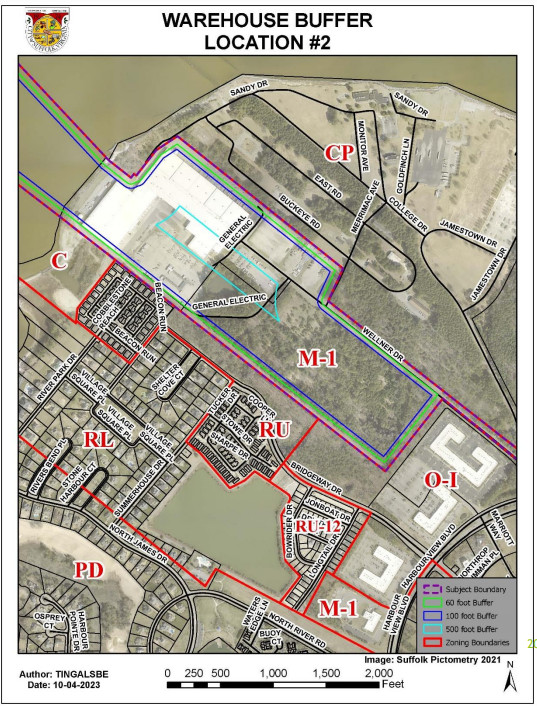
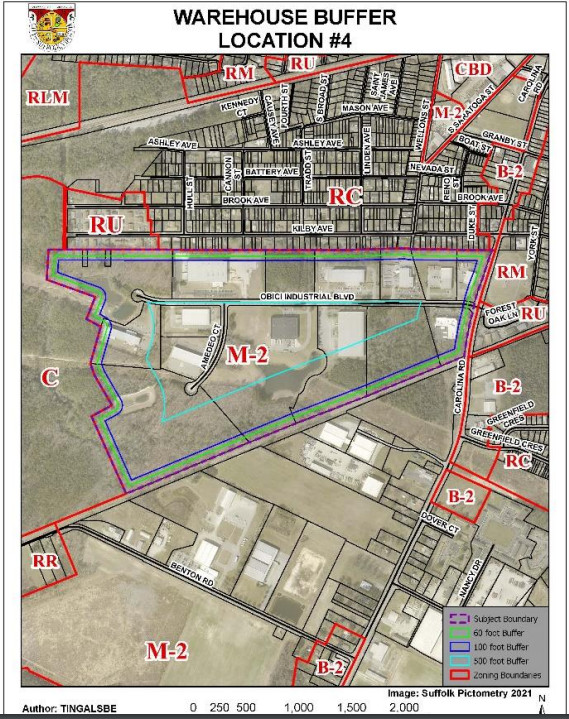
Above are the maps presented by the Planning Department at the October 18th City Council Work Session.
At the October 18th City Council Work Session, Kevin Wyne, Director of Planning and Community Development for Suffolk showed a series of maps with colored lines drawn on them to show the difference between the 30, 60, 100 and 500-foot setbacks. The City stated that it couldn’t require a 500-foot setback because of ‘regulatory taking’, which basically means that because too much of the land would be required for the setback, the owner would not be able to use the property.
So why just stick with 30 feet because 500 isn’t plausible? What about the other options of 60 or 100 feet? There was no mention of those distances or if they would be considered ‘regulatory taking’. There was no talk about why regulating a residential property to a 45-foot setback ISN’T ‘regulatory taking’ but increasing warehouse setbacks IS?
Instead of taking the feedback from the citizens of Suffolk into consideration, the City has listened to developers. The revised text amendment does not increase the buffers, which would protect Suffolk citizens’ quality of life. In fact, according to the UDO, M-2 zoning required 50-foot minimum side and rear setbacks. The new warehouse text amendment is just 30 feet. Did citizens just lose 20 feet of the previously required buffer? Why is the city even considering lowering it to 30 feet?
They also removed other aspects that had been in the draft, but presumably were objectionable to the developers. For instance, the draft version applied to public property, residential, agricultural, conservation, and recreational uses, and the public roadway network. The modified version removes conservation uses and agricultural uses.
Initially, it required pulsing back-up alerts for yard trucks and forklifts, which is a less noisy alert than the usual high-pitch beeping sound. Now this is just a recommendation, not a requirement.
There was also a requirement for truck/cab parking and stacking space dimensions of 14 feet x 75 feet. Now it is 12 feet x 60 feet.
Something else to note, is that the amendment only requires one parking space for every 10 bays/doors. There is a new warehouse complex set to be built across from the Amazon fulfillment center in Northgate Commerce Park that will have 150 bays, but only needs to have15 truck parking spaces available. Truck drivers are required to take breaks after certain driving times. Where are they supposed to go? Nobody wants them to risk driving while tired, both for their safety and everyone on the roads with them.
The City already acknowledges there is a problem with truck cabs parking on city streets and private lots. City Council Member Johnson asked the Planning Department, how do other areas deal with this? “Trucks are out of control,” Johnson stated, adding that it is getting to be a bigger and bigger problem. The City attorney says that we can’t require more amenities from the developers. City Council Member Fawcett’s solution was to just put up “no parking” signs. That may solve the problem of them parking on public streets, but it doesn’t provide a safe place to rest before they start driving again.
None of this addresses the real problem, which is that the Suffolk City Council has been rezoning land for years to allow for these warehouses and distribution centers with no plan in place to accommodate the traffic or the disruption to the citizens’ quality of life. This text amendment is a minimal effort that will do very little to offset these impacts. Instead of using it as a chance to help mitigate the negatives that come with warehouse development, the City has once again bent to the will of the developers and made this amendment toothless. The problems of road congestion, truck parking, noise and accidents will continue to get worse, unless the City decides to listen to its citizens over developers.
City Council will be voting on this text amendment on November 15th. Please email council members (council@suffolkva.us) to let them know what you think. Or better yet: come to the meeting and during the public hearing, let them know how this impacts you.
City Council Meeting Wednesday, November 15, 2023 at 6:00p. Address: 442 W Washington Street, Suffolk, VA 23434
